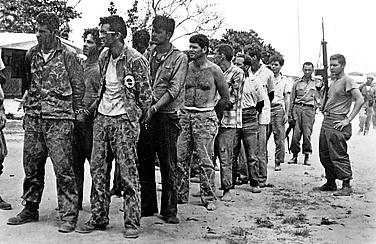In Iceland, where gender justice statistics are higher than in most other parts of the world, tens of thousands of women including the country’s Prime Minister Katrín Jakobsdóttir went on strike last week to observe “kvennafrí", or Women's Day Off. The planned walkout marked the first full-day women’s strike since 1975 and it shook the nation’s economy, even if just for a day, and became a jolting reminder of women’s contribution to the nation’s economy and production.
The strike evoked mixed reactions from certain quarters, especially from those living in nations where women face much harsher conditions across every aspect, be it employment, education, safety, and access to basic civil rights. Take India, for instance, which stood at the 135th position out of 146 countries in the United Nations’ (UN) Global Gender Gap (GGG) Index for 2022. Despite much advocacy and women’s rights movements across the world calling for equal rights and equality at work, only 14 nations in the world —including India— have laws that ensure equal pay. Even in these nations, implementation has proved to be difficult as statistics on women’s employment show. These laws and the consequent progress they have harnessed over the years have nevertheless been the result of the long and persistent fight by feminist organisations, activists, authors, and millions of ordinary women who have repeatedly taken to the streets for equality.
The war against the wage gap has been long and arduous and spread across the world. Here is a timeline of some of the significant events and protests related to the gender wage gap across the world so far:
Starting in the 19th and early 20th centuries, women’s suffrage movements around the world, such as in the United States (US), the United Kingdom (UK), and many European countries, advocated for women’s rights, including economic equality. These movements constituted the First Wave Feminism and laid the foundation for future protests related to the wage gap.
1911: Women teachers in New York fought a long and contentious battle with the Board of Education which finally granted them equal pay as their male counterparts, marking a significant precedent for women’s equality at work.
1918: The First World War pushed more women into work in countries like the US and UK, leading to calls and scattered protests for equal pay by workers, but the demand waned by the end of the war.
1949: The ‘Mops on the March’ protest saw 100 women cleaners marching in London with mops in hand to decry their low wages. Members of the UK’s Civil Service Union, these women were being paid a meagre 34c an hour and demanded a raise to 40c from Sir Stafford Cripps who was then the Chancellor of Exchequer. They carried placards with slogans that read “Cleanliness is next to Godliness. Women cleaners are next to starvation” among others.
1963: The United States passed the Equal Pay Act, which aimed to eliminate wage disparities based on gender for jobs requiring equal skill, effort, and responsibility. But women nevertheless failed to get equal opportunities or benefits of the act.
1968: Women sewing machinists making car seats at the Ford Motor Company in England’s Dagenham staged a walkout from the factory in July, demanding equal pay as their male counterparts. The high-profile protest ended after much negotiation and the women agreed to a 92 per cent raise. According to many, the protest had a far-reaching impact and, in fact, led to the passing of the Equal Pay Act in the UK in 1970.
1970: The Women’s Strike For Equality in the US spearheaded by second-wave feminists like Betty Freidan brought over 50,000 women to New York City on August 26, that year being the 50th anniversary of the passing of the 19th Amendment which gave women voting rights. The protest had three self-stated goals in general: free abortion, equal opportunity in the workforce, and free childcare.
1970s: The second wave of feminism led to a renewed focus on equal pay. Women in various countries, including the United States, the United Kingdom, and Canada, organised protests and demonstrations to raise awareness about the wage gap.
1975: Women’s collective efforts compelled the United Nations to host the First World Conference on Women in Mexico City, which discussed gender equality, including economic issues like the wage gap. Women in Iceland observe ‘Women’s Day Off’ on a massive scale for the first time.
1970s-80s: The Indian feminist movement strengthened with intersectional feminists from leftist, Ambedkarite, and liberal backgrounds leading protests against gender imbalance at the workplace and the pay gap among other issues. By 1976, the Indian government passed the Equal Remuneration Act, 1976 that brought a provisional ban on pay discrimination against women
1981: Following widespread protests, the Canadian government established the Royal Commission on the Status of Women, which brought attention to pay discrimination issues.
1990: Iceland’s “Women's Day Off” protest, where 90 per cent of women in the country walked out of their jobs to protest wage inequality and other gender disparities.
1994: Responding to years of advocacy, demonstrations and street protests by feminists, South Africa’s post-Apartheid government introduces legislation addressing employment equity and equal pay for equal work, aiming to bridge the wage gap between racial and gender groups.
Late 1990s and early 2000s: Various countries, including the United Kingdom and Australia, introduced legislation and programs to address pay equity and the gender wage gap.
2010: Feminists in Sweden burn wads of cash by barbecuing them in order to protest against the gender pay gap. The Feminist Initiative Party says that the burnt money is a symbol of the sum Sweden’s women miss out on every minute in comparison to men. The party reportedly burnt 100,000 Swedish kronor, a move that received criticism as “desperate” at the time. In 2008, Swedish women working full-time were earning 19 per cent less than men. In 2022, it stood 9.9 per cent, perhaps reflecting the success of such demonstrations.
2017: The “Day Without a Woman” protest takes place in the US, inspired by International Women’s Day. Women are encouraged to strike from work and engage in other forms of protest to draw attention to gender inequality, including the wage gap.
2017: The Women’s March, following the inauguration of President Donald Trump, brings millions of women, including LGBTQ+ women, to the streets across the country, advocating for gender equality, including pay equity. Spreading beyond the US, the march saw huge-scale international participation with an estimated 7 million people having reportedly marched peacefully all over the world on that day including remote countries like Antarctica — to advocate human rights, freedom, and equality for all. Organised largely through social media hashtag campaigns, one of the most enduring images of the march was the pink “pussyhat”, a campaign that urged people to knit and sew over a million hats that protesters wore across the marches.
2018: Women of Brazil took to the streets en masse against the reelection of President Jair Bolsonaro who has vehemently justified sexual violence and gay the country’s yawning gender wage gap. Millions also tweeted the hashtag #NotHim to mark their dissent. This was not the first or last time Brazilian women have taken to the streets against Bolsonaro’s sexist statements and politics.
2019: The “Un Dia Sin Nosotras” (A Day Without Us) protest in Mexico sees millions of women staying home from work and other activities to protest gender-based violence and discrimination, including unequal pay.
2020: The COVID-19 pandemic exposes and exacerbates gender and LGBTQ+ disparities in the workforce. Protests and advocacy efforts focus on these disparities and the need for better workplace policies.
2021: To mark Women’s’ Day, about 30,000 women, activists and workers participate in a “feminist strike” in Paris, France, to protest against the “25 per cent pay gap” between men and women. Women showed up in their work uniforms, and many carried musical instruments to make their point peacefully.
2022: Hundreds of mothers accompanied by Nigerian feminist author Chimamanda Ngozi Adichie and others took to the streets of the UK in October to participate in the “March of the Mummies”. Organised by a civil society group called Pregnant Then Screwed, the protest was meant to call for reforms to the childcare sector in the UK which exploits women’s unpaid work.
2023: ‘Barbie’ film actors and writers went on a strike to demand better pay and conditions in July, ahead of the film’s release. Ironically, the film won accolades on social media for making a point about gender roles in the real world. In fact, members of the Screen Actors Guild-American Federation of Television and Radio Artists (SAG-AFTRA) and Writers Guild of America (WGA) among others have been protesting against the same for some time. The typical actor part of such unions, regardless of sex, made just $53,170 in 2021 which is low as per American standards. But women actors make substantially less.
2023: Iceland makes a strong statement with even the Prime Minister joining the women’s strike for a day in solidarity against the gender gap and gender-based violence.


























